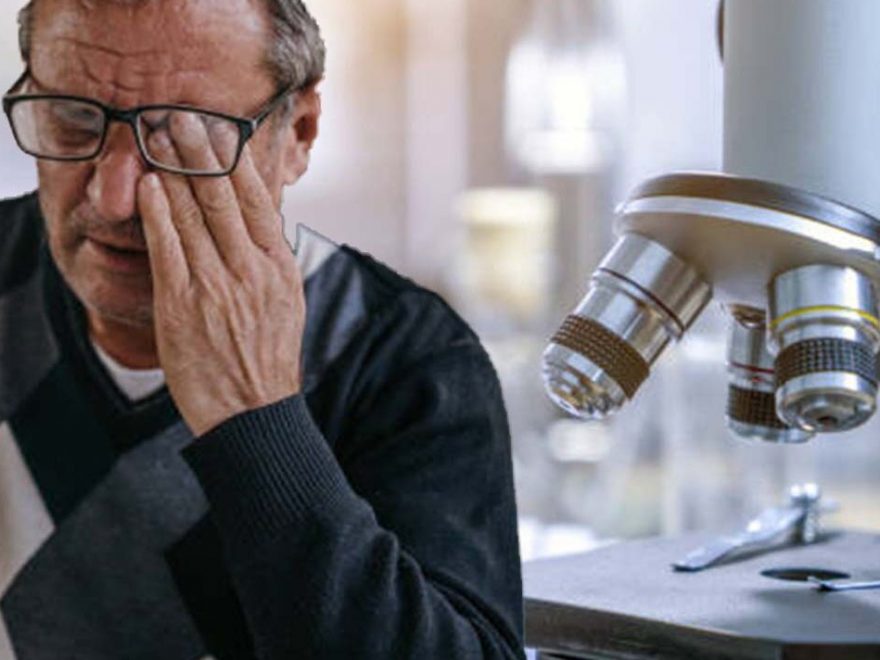Malandra Burrows reveals her dog discovered her cancer
We use your sign-up to provide content in ways you’ve consented to and to improve our understanding of you. This may include adverts from us and 3rd parties based on our understanding. You can unsubscribe at any time. More info
The NHS says eye cancer does not always cause obvious symptoms and may only be picked up during a routine eye test. Symptoms of eye cancer can include shadows, flashes of light, or wiggly lines in your vision or blurred vision. Other people notice a dark patch in their eye that’s getting bigger or partial or total loss of vision.
The NHS says other signs include the bulging of one eye, a lump on your eyelid or in your eye that’s increasing in size or pain in or around your eye, although this is rare.
The health body notes: “These symptoms can also be caused by more minor eye conditions, so they’re not necessarily a sign of cancer. But it’s important to get the symptoms checked by a doctor as soon as possible.”
Cancer that starts in the eye is called primary eye cancer, but sometimes cancer can spread to the eye from another part of the body. This is called secondary eye cancer.
Cancer Research notes: “In women this is most likely to happen with breast cancer, and in men this is most likely to happen in lung cancer.”

Cancer Research says eye cancer is very rare. Around 850 cases are diagnosed in the UK every year.
It adds: “Remember that cancer of the eye is rare. Eye conditions that aren’t eye cancer can cause many of these symptoms. It is important that you report any of them to your GP or optometrist.“
The charity explains that an optometrist is a healthcare professional trained to examine the eye.
It says: “They can identify conditions and diseases that affect the eye including eye cancers. They will then refer you to an ophthalmologist (eye doctor) for specialist treatment.”
It adds: “The earlier a cancer is picked up, the easier it is to treat it. This makes it more likely for the treatment to be successful.”
It adds: “You should see your doctor or optician if you notice a change that isn’t normal for you or if you have any of the possible signs and symptoms of eye cancer.”
The NHS says that eye melanoma occurs when the pigment-producing cells in the eyes divide and multiply too rapidly. This produces a lump of tissue known as a tumour.
It says it’s not clear exactly why this occurs, but the following factors may increase the risk of it happening:
- Lighter eye colour – if you have blue, grey or green eyes, you have a higher risk of developing eye melanoma compared with people who have brown eyes
- White or pale skin – eye melanoma mostly affects white people and is more common in those with fair skin
- Unusual moles – if you have irregularly shaped or unusually coloured moles, you’re more at risk of developing skin cancer and eye melanoma
- Use of sunbeds – there’s some evidence to suggest that exposing yourself to ultraviolet (UV) radiation from sunbeds, for example, can increase your risk of eye melanoma
- Overexposure to sunlight – this increases your risk of skin cancer, and may also be a risk factor for eye melanoma.

The NHS adds: “The risk of developing eye melanoma also increases with age, with most cases being diagnosed in people in their 50s.”
Macmillan says after treatment for eye melanoma you will see your ophthalmologist and specialist nurse again for a follow-up appointment.
It states: “You will probably have regular checks for a few years. Your doctor or specialist nurse will explain how often you will see them.
“Your doctor or specialist nurse will check your eye and the surrounding area. You may have scans or x-rays to check both the eye and other parts of the body. If you have any problems or notice any new symptoms between these appointments, tell your doctor. You do not need to wait until your next appointment.”
Source: Read Full Article
